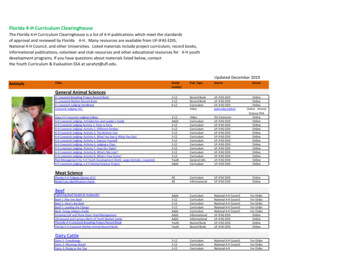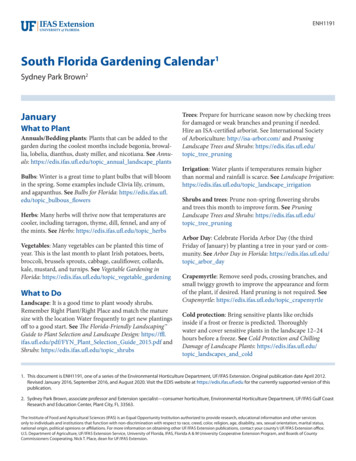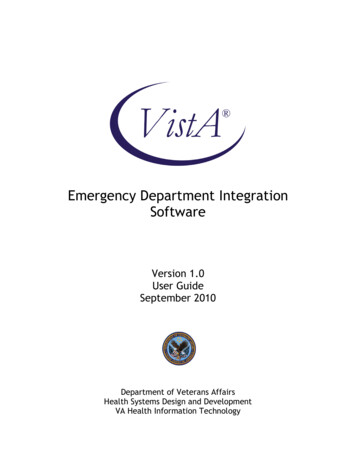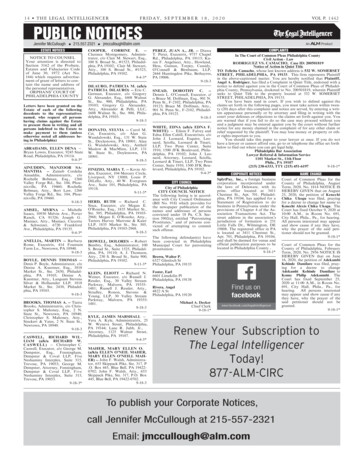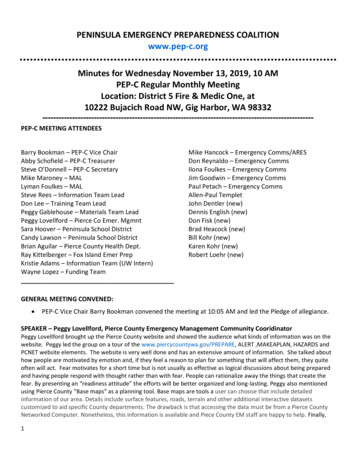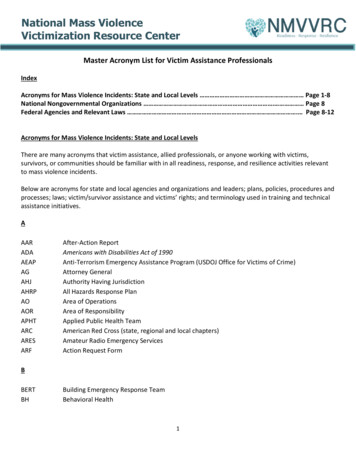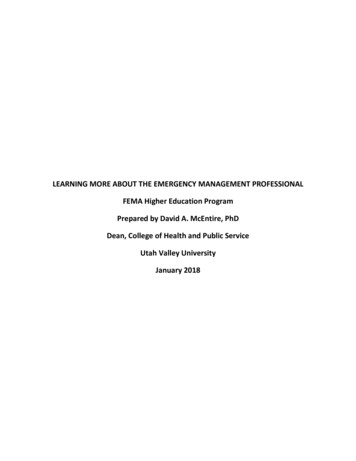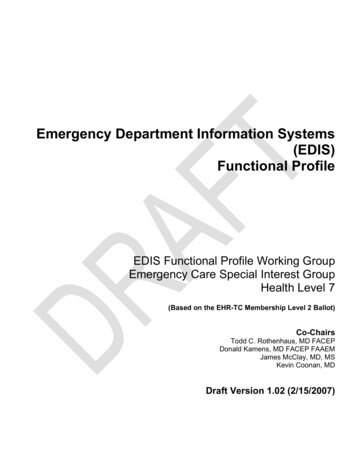
Transcription
Emergency Department Information Systems(EDIS)Functional ProfileEDIS Functional Profile Working GroupEmergency Care Special Interest GroupHealth Level 7(Based on the EHR-TC Membership Level 2 Ballot)Co-ChairsTodd C. Rothenhaus, MD FACEPDonald Kamens, MD FACEP FAAEMJames McClay, MD, MSKevin Coonan, MDDraft Version 1.02 (2/15/2007)
EDIS Functional Profile Draft Version 1.02 - Emergency Care Special Interest Group – HL72EDIS Functional Profile Working GroupHL7 Emergency Care Special Interest Group Co-chairsTodd C. Rothenhaus, MD FACEPBoston University School of MedicineDonald R. Kamens, MD FACEP FAAEMXPress TechnologiesJames McClay, MD MSUniversity of Nebraska Medical CenterKevin Coonan, MDUniversity of Utah School of MedicineEDIS Functional Profile Working GroupJack BrownRandy Case, MD FACEPDennis G. Cochrane MD FACEPKeith Conover, MDSteve J. Davidson, MDJohn EplerJT Finnel, MDM. Catherine Glenz RN, BSNJohn R. GriffithMark Jaben, MDNeal Handly, MDRichard Hartl MDLaura Heermann Langford, RN, PhD.Daniel MyungJA Magnusun, MDDonna Mitchell, RNJeff Nielson, MDDan Pollack, MDUhri RandhasEric RockJohn Santmann MDBharat Sutariya MD, FACEPChris Thompson, MD, FACEPFebruary 2007Copyright 2007 HL7, All Rights ReservedT-System, Inc.IBMMorristown Memorial Hospital, Morristown, NJUniversity of PittsburghMount Sinai School of MedicinePicisRegenstrief InstituteAlert Life Sciences Computing, Inc.MEDHOST, Inc.Haywood Regional Medical CenterDrexel University College of MedicineWellsoft, IncIntermountain HealthcareBoston UniversityOregon Department of Human ServicesTouch Medix, LLCSumma Health SystemCenters for Disease ControlMEDHOST, Inc.MEDHOST, Inc.Wellsoft, Inc.Cerner CorporationTouch Medix, LLCEHR TC Work-in-Progress
EDIS Functional Profile Draft Version 1.02 - Emergency Care Special Interest Group – HL73Emergency Department Information Systems (EDIS) - Functional ProfileEmergency Care Special Interest Group – HL7IntroductionThe EDIS Functional Profile (EDIS-FP) project of the HL7 Emergency Care Special Interest Group (EC-SIG) is aimed atdeveloping an HL7 Normative Functional Profile for emergency department information systems, conforming to the HL7Electronic Health Record (EHR) Functional Model. By creating a robust and usable functional profile outlining theessential functions of an EDIS, and including specific conformance criteria for their evaluation, we hope to develop anopen and objective standard for the development, refinement, evaluation of information systems employed in the ED.BackgroundFounded in 1987, Health Level Seven is a not-for-profit healthcare standards development organization (SDO) accreditedby the American National Standards Institute (ANSI). While traditionally involved in the development of messagingstandards used by healthcare systems to exchange data, HL7 has begun to develop other standards related to healthcareinformation systems. In 2002, a newly formed HL7 EHR special interest group began development of a functional modelfor electronic health record systems (EHR-S). Shortly thereafter, a number of organizations approached HL7 to develop aconsensus standard to define the necessary functions for an EHR-S. The EHR SIG was promoted to a full technicalcommittee, and in 2004 published the EHR-S Functional Model as a Draft Standard for Trail Use (DSTU). [1] TheFunctional Model underwent membership level ballot in September of 2006 and January 2007, and was approved asstandard in February 2007. The EHR-TC intends that unique functional profiles (herein referred to as profiles) bedeveloped by subject matter experts in various care settings and specialties (i.e. behavioral health, inpatient, anesthesia,long-term care) to inform developers, purchasers, and other stakeholders of the functional requirements of systemsdeveloped for these domains.The HL7 EC-SIG was founded last year to inform HL7 and other healthcare standards development organizations (SDOs)of the unique requirements and workflows of emergency care. In an effort to obtain the widest participation possible, theEC-SIG co-chairs solicited input and membership from domestic and international specialty societies, including ACEP,SAEM, AAEM, ENA, and the Canadian and Australasian Emergency Medicine Societies. Participation was solicited fromthe vendor community through invitations and presentations. At the initial meeting of the SIG, the co-chairs unanimouslyagreed that one of its initial work products be a functional profile for EDIS. The American College of EmergencyPhysicians (ACEP) sponsored membership in the EC-SIG in the form of funded awards for travel and expenses to HL7meetings. Infrastructure was secured from an unrestricted grant from XPress Technologies to set up an intranet site andweekly teleconferences to supplement face to face meetings at HL7 conferences. An EDIS-FP workgroup was convenedthat currently includes over thirty physicians, nurses, medical informatics experts, EDIS developers, and engineers.Membership in HL7 is not a prerequisite for participation.The Certification Commission on Health Information Technology (CCHIT) adopted the EHR FM in 2005 as a tool forevaluation of ambulatory systems. Based upon evaluation criteria developed from the EHR Functional Model, CCHITbegan certification of these systems in 2006. CCHIT recognizes the value of expanding certification to address particularspecialties, care settings, and specific patient populations, and has begun pursuing expansion of certification. ACEPendorsed concept of certification and the development of a unique EDIS-FP in a letter to CCHIT in 2005, and begancoordinating activities with the SIG and WG to promote adoption of the FP as the basis for CCHIT certification for EDIS. InJanuary, the EC-SIG and ACEP coauthored a response to the CCHIT environmental scan further promoting the EDIS FPas the principle framework for developing EDIS certification. On the basis of this profile development, CCHIT announcedtheir proposal to expand certification to EDIS systems in February of 2007, with certification commencing sometime in late2008 or early 2009.Methods and Project PlanThe project was structured into four discrete phases:1. Organization – solicitation of participants, determination of scope and care setting of profile, and development ofproject plan and overview.2. Formalization – step by step development of EDIS functions and conformance criteria.3. Harmonization –comparison with, incorporation into, and alignment with the EHR FM. Define functional priorities and timeframes (see below) for functionsFebruary 2007Copyright 2007 HL7, All Rights ReservedEHR TC Work-in-Progress
EDIS Functional Profile Draft Version 1.02 - Emergency Care Special Interest Group – HL7 4Accept or reject other functions from FM.Incorporate unique EDIS functions defined in step 2 through sibling child relationships with EHR FM functionsIncorporate and modify conformance criteria4. Finalization – attention to detail, wording, language, and conformance in preparation for EHR – TC registration,verification and balloting.We began the EDIS-FP project by taking a broad look at the functions required of ED systems, with only organizationalreference to the EHR FM. We employed this methodology to maximize the potential discovery of functions that the EHRTC may not have considered in the FM. It has also permitted us to approach the project using an outline familiar to peopleworking in emergency medicine. We began with a typical scope of ED care, beginning with a “heads-up” and movingthrough patient arrival, triage, nursing and physician assessment, orders, results, procedures, ongoing assessments, andfinally admit/transfer/discharge planning. Use case methodology was employed where appropriate.Harmonization of the workgroup product and the EHR FM was performed in order for the profile to become an HL7Balloted Functional Profile. First time readers should be understand that the EHR-TC has defined specific methodologiesfor profile development and conformance, which are outlined in the How-To Guide for Creating Functional Profiles andConformance Clause sections of the EHR functional model. [4] The workgroup has identified a writing committee and is inthe process of publish a summary document targeted to practicing emergency department providers and managers to useas a guide to system evaluation and selection.The development of the EDIS FP has and continues to employ a traditional, open, standards development approach.Everyone’s contributions and concerns are addressed, and your input is welcome.EDIS: Definition, Standards, Implementation and InteroperabilityAn Emergency Department Information System (EDIS) is an extended EHR system used to manage data insupport of Emergency Department patient care and operations. The functions of an EDIS may be provided bya single application or multiple applications.Standards Basis for this EDIS Definition: The EDIS functional profile is a standards work derived from the HL7 EHRFunctional Model, which is in turn based on ISO/TR-20514 Health informatics -- Electronic health record -- Definition,scope and context. [3] According to the ISO EHR standard:“The primary purpose of the EHR is to provide a documented record of care that supports present and future careby the same or other clinicians Any other purpose for which the health record is used may be consideredsecondary.”“The Core EHR contains principally clinical information; it is therefore chiefly focused on the primary purpose.The Core EHR is a subset of the Extended EHR. The Extended EHR includes the whole health informationlandscape; its focus therefore is not only on the primary purpose, but also on all of the secondary purposes aswell. The Extended EHR is a superset of the Core EHR.”The EDIS FP workgroup decided that while many of the functions that form a traditional EDIS (i.e. charting, order entry,results reporting, and) may constitute core EHR functions, other functions (i.e. patient tracking, disposition management,financial, and administrative) clearly constitute important secondary uses of an EDIS.Systems, Components & Applications: Emergency departments have fundamental commonalities, but each is alsodifferent. Each EDIS may likely consist of a collection of systems, applications, modules, or components, developedon different architectures. For example, an ED might pair one vendor's clinical documentation system with another'stracking, discharge, or prescribing system. Hence, an EDIS may be provided by a single vendor, multiple vendors, or byone or more development teams.Interoperability: All components, modules, or applications within an EDIS should respond to users in a well integratedfashion. Thus each component, module or application must be interoperable to the degree required by the functiondescription and conformance criteria specified in this profile. ISO 20514 states: The key to interoperability is throughFebruary 2007Copyright 2007 HL7, All Rights ReservedEHR TC Work-in-Progress
EDIS Functional Profile Draft Version 1.02 - Emergency Care Special Interest Group – HL75standardization of requirements for the EHR (record) architecture (e.g. ISO/TS 18308:2004) and ultimately thestandardization of the EHR architecture itself (e.g. ENV 13606-1:2000).Organization of this DocumentThe profile is divided into three sections: Direct Care, Supportive Functions and Information Infrastructure. Each sectiondefines a broad category of functions applicable to an EDIS. Because of this organization, many traditional concepts andtasks typical of traditional ED can be found interspersed throughout the document, depending upon whether aspectsconstitute patient tracking, administrative functions, clinical workflow, tasks/orders, clinical documentation, or clinicaldecision support, etc. For example, items related to the ED triage process can be found in documentation as well asclinical decision support. Readers looking for a general overview of typical ED functions should refer to the EDISOverview and Functions section at the end of this introduction.Functions employed in the provision of care to individual patients. Direct care functionsare the subset of functions that enable delivery of healthcare or offer clinical decisionsupport.Direct CareDC.1Care ManagementDC.2Clinical Decision SupportDC.3OperationsManagement andCommunicationFunctions that support the delivery and optimization of care, but generally do not impactthe direct care of an individual patient. These functions assist with the administrative andfinancial requirements associated with the delivery of healthcare, provide support formedical research and public health, and improve the global quality of healthcare.SupportiveFunctionsS.1Clinical SupportS.2Measurement, Analysis, Research and ReportsS.3Administrative and FinancialInformationInfrastructureFunctions that define the heuristics of a system necessary for reliable, secure andinteroperable computing. These functions are not involved in the provision of healthcare,but are necessary to ensure that the EDIS provides safeguards for patient safety,privacy and information security, as well as operational efficiencies and minimumstandards for interoperability. Functions may be provided by the EDIS itself, by thesupporting infrastructure, or a combination of both.IN.1SecurityIN.2Health Record Information and ManagementIN.3Registry and Directory ServicesIN.4Standard Terminologies and Terminology ServicesIN.5Standards-based InteroperabilityIN.6Business Rules ManagementIN.7Workflow ManagementIN.8Application PerformanceFebruary 2007Copyright 2007 HL7, All Rights ReservedEHR TC Work-in-Progress
EDIS Functional Profile Draft Version 1.02 - Emergency Care Special Interest Group – HL76Functional PrioritiesThe EHR TC and EC-SIG recognize that clinical computing is an evolving field, and that many of the desired functions ofEHR-S are not currently available. Certain functions, for instance access to regional health information, may not befeasible or essential now because widespread adoption of regional health information organizations (RHIOs) has yet tooccur. Nevertheless, it is important for functional profiles to outline major trends and articulate a vision for functionality(especially interoperability) for the future. Furthermore, the delineation of potential functions for future implementation andadoption should guide vendors in development, and help purchasers develop and articulate to vendors a strategic visionfor future functional requirements.Each function in the profile is assigned a single priority as follows:EEssentialNowThe function must be available and users must be able to implement it.In assigning this priority, the workgroup believes that the function is critical tothe delivery of care in the ED. When determining the priority for a particularfunction, the workgroup determined that such functions should support thedelivery of effective healthcare, ensure patient safety, and maximize EDefficiency.E [YY]EssentialFutureThe function must be available and users must be able to implement it before the twodigit year indicated.In assigning this priority, the workgroup understands that these functions maynot be available at present, but are part of a general trend towards additionalfunctionality that should be possible as standards development and ITimplementations mature. The assignment of these functions should informsystem developers and purchasers of a general roadmap for futurefunctionality in EDIS.OOptionalThe function is desirable but not a critical component of an EDIS.In assigning this priority, the workgroup believes that these functions shouldbe considered helpful features of an EDIS, but are not critical for ED care oroperations.Conformance ClauseThis draft profile is based on HL7 EHR-TC Membership level 2 ballot. [4] As the EHR Functional model has recently beenapproved as standard, we anticipate that in the near future a revision will be released that conforms to the approvedstandard.Key to the Functional Model and derived profiles is the concept of conformance which may be defined as “verification thatan implementation faithfully meets the requirements of a standard or specification” [2]. In the functional model and inderived profiles, the general concept of conformance may be expressed a number of forms. For instance, a profile can besaid to conform to the functional model if it adheres to the defined rules specified by the functional model specification.Similarly, an EDIS may claim conformance to this profile if it meets all the requirements outlined in the profile.Conformance of ED Information SystemsThis EDIS Functional Profile defines two levels of conformance for an EHR system or systems employed in theemergency department domain.1. “Basic Conformance” is comprised of the functions designated as ‘Essential Now’. As of the date of this publication, to claim “Basic Conformance” with the EDIS FP, an EHR system shallinclude all functions designated as ‘Essential Now’, and each function must satisfy the conformance criteriadesignated as ‘SHALL’. In the future, and until such time as this Functional Profile is revised, to claim “Basic Conformance” with theEDIS FP, a EHR system shall include all functions designated as ‘Essential Future’ with the implementationyear equal to or less than the year in which conformance is claimed, as well as functions designated as‘Essential Now’, and each function must satisfy the conformance criteria designated as ‘SHALL’.2. “Advanced Conformance” comprises the set of functions designated as ‘Essential Now’ as well as ‘Optional’.February 2007Copyright 2007 HL7, All Rights ReservedEHR TC Work-in-Progress
EDIS Functional Profile Draft Version 1.02 - Emergency Care Special Interest Group – HL7 7As of the date of this publication, to claim “Advanced Conformance” with the EDIS FP, an EHR system shallinclude all functions designated as ‘Essential Now’ and ‘Optional’, and each function must satisfy theconformance criteria designated as ‘SHALL’.In the future, and until such time as this Functional Profile is revised, to claim “Advanced Conformance” withthe EDIS FP, a EHR system shall include all functions designated as ‘Essential Now’ or ‘Essential Future’ withthe implementation year equal to or less than the year in which conformance is claimed, as well as functionsdesignated as ‘Optional’, and each function must satisfy the conformance criteria designated as ‘SHALL’.Conformance of Derived ProfilesThe EDIS Functional Profile Working Group recognizes that developers, users, and other members of the EDIScommunity may wish to develop their own profiles. The Working Group contends that the EDIS FP includes all thefunctions that might be reasonably expected to be available in an EDIS. However, we also recognize the value in thedevelopment of derived profiles applicable to certain subsets of EDIS systems. In fact, the workgroup strongly feels thatthe development of derived profiles will likely be essential to support the evaluation of systems designed to supportsubsets of EDIS functions. Based upon feedback from vendors, we anticipate that derived profiles for tracking and clinicaldocumentation should be developed to support certification in those niches within the EDIS space. Other profiles may berequired.In order for a derived profile to claim conformance with the EDIS FP, the profile must include all essential functions asoutlined above. Furthermore, a derived profile must not claim conformance if the derived profile includes functions thathave not been defined in this EDIS FP. The Workgroup solicits feedback regarding functions encountered in thedevelopment of a derived profile not encountered in the EDIS FP.Conformance CriteriaEach function defined in the model or profiles is associated with specific conformance criteria which are evaluablestatements (i.e. “the system SHALL capture, display and report all immunizations associated with a patient”) used todetermine if a particular function is met.Conformance criteria have been developed in accordance with the standards set forth by the EHR technical committee. Inorder to ensure consistent, unambiguous understanding and application of the functional profile, the use of a consistentset of keywords (normative verbs) have been employed to describe conformance requirements.February 2007Copyright 2007 HL7, All Rights ReservedEHR TC Work-in-Progress
EDIS Functional Profile Draft Version 1.02 - Emergency Care Special Interest Group – HL78Normative LanguageThe key words SHALL, MUST, SHOULD, MAY, and RECOMMENDED in this document are to be interpreted asdescribed in RFC 2119 (available at: http://www.ietf.org/rfc/rfc2119.txt) SHALL – indicates a mandatory, required action. Synonymous with ‘is required’.MUST – equivalent to ‘SHALL’SHOULD – indicates an optional, recommended action that is particularly suitable, without mentioning or excludingother actions. Synonymous with ‘is permitted and recommended’.MAY – indicates an optional, permissible action. Synonymous with ‘is permitted’Additional, clarification is necessary to understand the standardized nomenclature used to describe the functions of asystem. The following chart, adapted from the EHR FM, illustrates the hierarchy of nomenclature. For example, “capture”is used to describe a function that includes both direct entry “create” and indirect entry through another device “input”.Similarly, “maintain” is used to describe a function that entails reading, updating, or removal of data.MANAGECaptureMaintainInput Device (Ext.)Create (Int.)Read(Present)UpdateRemove ntObsoleteInactivateDestroyNullifyPurgeEDIS UsersThe ED is a unique care setting where a number of non-clinical associates as well as administrators and managers musthave access to the system. Furthermore, users may at different times have different roles. For instance, a nurse may onone day work as a nurse, while on another day work as a nurse practitioner. This profile was developed for the US realm.However we feel it is highly applicable to international settings with the understanding that language used to describepotential users of the system may require clarification.The following table should be used as a guide to the nomenclature used to describe users who may interact with an EDIS.This table is not intended to serve as a hierarchical description of ED roles or as a description of access control policies,attributes, or credentials, but is intended to provide a means to rigorously define different groups of users. For instance,functions pertaining to the functions related to prescribing are usually granted to physicians, physician assistants andnurse practitioners, so users of such functions would be described as a ‘licensed prescriber’ but not as a ‘user’ or a‘provider’.UserStaffProviderLicensed PhysicianAssistantAttending PhysicianNon-EDEDbasedResidentAttendingEHR TC Work-in-ProgressED-basedAttendingFebruary 2007Copyright 2007 HL7, All Rights ReservedResidentNon-EDbasedResident
EDIS Functional Profile Draft Version 1.02 - Emergency Care Special Interest Group – HL79EDIS Overview and FunctionsThe following section describes some of the major functions and tasks essential in an EDIS.TrackingIn emergency medicine, the concept of tracking connotes multiple concepts. Tracking may refer to the tracking of thepatient’s physical location as well as the patient’s progress through an ED encounter (i.e. arrival, in room, awaitingconsults, awaiting labs, ready for discharge). Tracking physical location can be accomplished by capturing updates to thepatient’s location that are manually entered by users into the system, or it can be done in an automated fashion usingradio-frequency ID (RFID) or other technologies. The system should track patient physical location through all phases ofvisit, from pre-arrival through disposition. At certain times the actual location of the patient may require supportinginformation. For instance, a patient who has been sent to radiology may require his or her patient room to be “saved”because the patient’s family members or personal belongings remain.Tracking the status of care is covered in Clinical Workflow Tracking and Task Management. Tracking of patient’s progressthrough the ED encounter requires the capture of certain milestones in the business logic behind the system. Forinstance, when a patient is moved from the waiting room to a patient room, the time the patient entered the treatment areashould be automatically captured. Similarly, a chair in a hallway would be considered equivalent to a patient room in termsof capturing this milestone.RegistrationPatient arrival and registration are relatively complex and time-sensitive tasks involving data capture of both clinical andadministrative data. In most cases, the EDIS is not the primary system used to capture the gamut of demographic oradministrative information. Instead, a record is generated in the EDIS upon patient entry, and further demographic andadministrative data are sent to the system via HL7 messaging once the patient is formally registered into the hospital ADTsystem. Critical to this workflow is the ability to manage the patient before formal registration has occurred, theidentification of a single patient ID and record in both the EDIS and hospital systems, timely generation of a hospitalaccount or billing number to facilitate interoperability with other hospital systems. The process of merging administrativedata captured in the hospital system with the unique patient record in the EDIS should be largely automated, and onlyrequire human intervention if errors in either process prevent a certain match of the data.Because the emergency department patient is ideally first encountered by a clinical provider (i.e. triage nurse) and notregistration personnel, a search for past visits in the EDIS should be available to providers to retrieve medical summarydata that has been captured in previous visits, including the patients’ problem list, medications or allergies. While finding apatient’s record may take time, past encounter data may streamline the intake or triage process, especially for patientswith complicated medical histories or for patients unable to give an accurate history. Conversely, identification of apatient’s previous visits prior to triage or formal registration should not be required. In fact, it should be possible to enter apatient into the EDIS without any demographic information (i.e. John or Jane Doe).Quick registration is another process that allows clinical providers to enter the minimal amount of data sufficient togenerate a new encounter or account number for the patient. This permits clinicians to order tests and other procedureson the patient although formal registration and verification of administrative data has not yet occurred. Full registration isthe process whereby administrative personnel capture the entire spectrum of demographic information including contacts,addresses, and insurance information. Alternative workflows are possible and may be necessary for some EDISimplementations.Clinical Workflow and Task ManagementIn the ED, there exists a critical need for distributed communication of the status of workflow tasks. An essential EDISfunction is the management and display of tasks to be accomplished. In the pre-EHR era, this was accomplished byvarious artifacts including grease boards, chart racks, stickers, etc. Systems implemented in the ED must seek to achievea level of embedded buy-in and participation as have these time-tested and home-grown artifacts. Communication ofpriorities is difficult in the ED. Work to be done is constantly changing. For instance, a critically ill patient has the effect ofimmediate re-prioritizing all workflow. In the ED, shifting of priorities is the norm, not the exception.The management of tasks within the EDIS requires the maintenance of a master set of tasks, the ability to invoke thosetasks, and a method for displaying those tasks. Tasks include orders, consultations, clinical tasks such as transportationto radiology, and flags for patient follow-up, etc. Tasks must be assigned to at least one entity, and in the ED are usuallyassigned to a member of the healthcare team or to a department (i.e. radiology). Tasks are also either linked to aparticular patient, or occasionally to infrastructure in the ED (i.e. a bed that needs cleaning). The EDIS should beFebruary 2007Copyright 2007 HL7, All Rights ReservedEHR TC Work-in-Progress
EDIS Functional Profile Draft Version 1.02 - Emergency Care Special Interest Group – HL710extensible enough to accommodate the complexity of clinical task routing according to local needs. For instance, in oneED, the assignment of an order for a “Chest Radiograph” may be assigned to the patient’s primary RN alone, who carriesout the task of ordering the study in the hospital information system and contacting transport to take the patient to theradiology department (sub-optimal). In another ED, the same task might entail the creation of multiple sub-tasks to: alertthe primary RN that the patient requires transport out of the department; alert the radiology technologist to perform thestudy; alert the transporter to transport the patient to radiology; send an HL7 message to the radiology system orderingthe study.The system must link every clinical task to a particular patient and resource. Resources may include members of thehealth care team, objects such as stock items, and on occasion a place in the ED chart. For instance, an order for anECG could be linked to the patient’s primary ED nurse, to the hospital heart station, to the ECG section of the chart toprompt the ED physician for an interpretation, and to the charge capture system. The system must also dis
Emergency Department Information Systems (EDIS) Functional Profile EDIS Functional Profile Working Group Emergency Care Special Interest Group Health Level 7 (Based on the EHR-TC Membership Level 2 Ballot) Co-Chairs Todd C. Rothenhaus, MD FACEP Donald Kamens, MD FACEP FAAEM James McClay, MD, MS Kevin Coonan, MD Draft Version 1.02 (2/15/2007)
